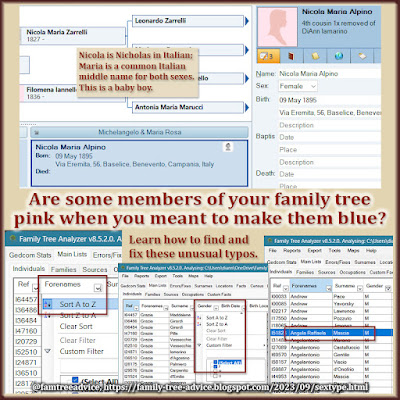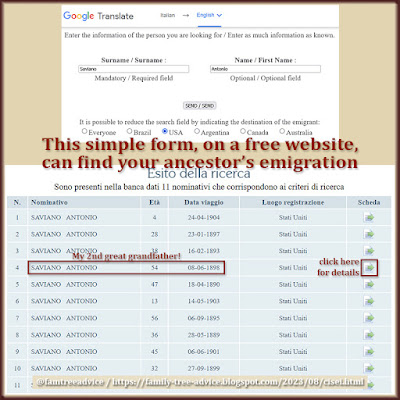I spent too many months fixing errors in my family tree to tolerate any more. I knew my previous lemon of a computer was the main source of the errors. Tons of duplicate source citations were born of failed syncs between Family Tree Maker and Ancestry.com. (See "Take the Time to Improve the Sources in Your Family Tree.")
Recently, I keep seeing another type of error. I'll notice a person with a male name marked as a female. I wondered if it was a typo I kept making. When I add a new name, my fingers are so fast on the keyboard that I sometimes press F for female before I realize it. I've caught myself doing it, and then I can fix it before moving on.
How many of these typos are in my huge family tree? How many men did I mark female? How many women did I mark male? How can I find them all?
 |
| Is this type of error hiding in your family tree? |
Don't read anything snarky or political into this subject matter because it isn't there. There's one very important reason to make sure you've used the right gender. If you wind up with a wife labeled male, the couple's children will get her last name. Is that how names work in your culture?
The less important reason for fixing this error is you don't want to look like you don't know what you're doing. If you're recording history, you've got to strive for accuracy. I record each person by the name on their birth certificate, even if they went by another name in life. So I'm going to record their sex, too.
Looking for an Easy Way to Spot the Error
Since I use Family Tree Maker to build my tree, I wondered if a filter might help. I created a filter of all people in the tree with a sex of female. That cut my 66,000-person family tree list of names about in half. But that's too many names to scroll through and spot the out-of-place names.
I thought of Family Tree Analyzer because I knew I could sort the data like a spreadsheet. I opened my latest GEDCOM file and went to the Main Lists / Individuals tab. I sorted the Forenames column from A to Z (an important first step). Then I filtered the Sex column to display only F for female.
If you only keep your family tree online and do your work there, download a GEDCOM from the website. Open the file on your computer with Family Tree Analyzer, and make all the corrections one by one.
My list was still long, of course, but it didn't take too long to scan. With the first names in alphabetical order, I could scroll quickly past everyone named Maria, for instance. I acted on 4 types of first names:
- Clearly male names. If you have lots of names based in another language, understand the rules of that language. Most of my Italian first names ending in the letter a will be female, but there are exceptions. Nicola, Mattia, Andrea, Giambattista, Zaccaria, etc.
- Possibly male names. Among my Italian ancestors, the first name Felice could belong to either a male or a female. In English, think of a name like Dana or Chris.
- Typos that stood out in the alphabetical list. I saw Antona instead of Antonia.
- A last name as a first name. A name like Viola may be a first name, but in my tree it's also a last name. I need to see this person's full name. Italian names are often written last-name-first on vital records, so I may have absentmindedly entered a name backwards.
Of all the females, there were 92 I needed to review in my family tree and a much smaller number to change to male. When I finished, I changed my filter in Family Tree Analyzer to display only people with an M in the sex column. I scanned the long list for any female names, questionable names, or typos. I didn't count them, but there were at least 10 I changed to male.
If you're working on your family tree, a wrong-sex error is very visible when you find one. The person's name may be in a field of pink instead of blue, or they're on the left side when you expected them to be on the right.
I don't know how each of these errors happened. Now that it's top-of-mind, I'm hopeful I won't keep making the wrong choice out of muscle memory.


